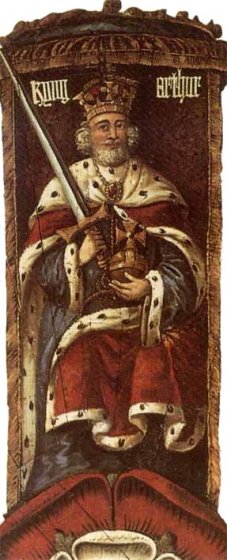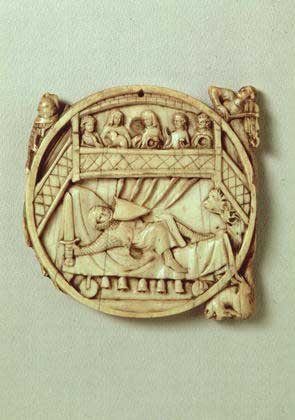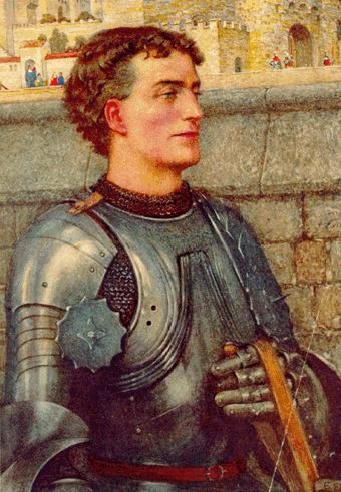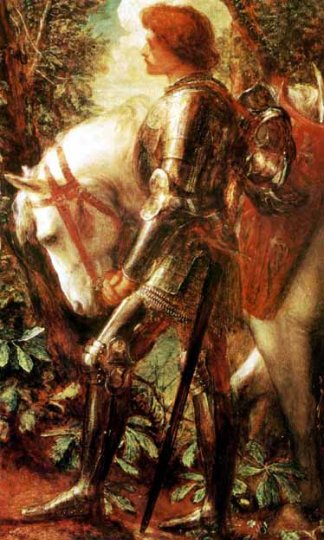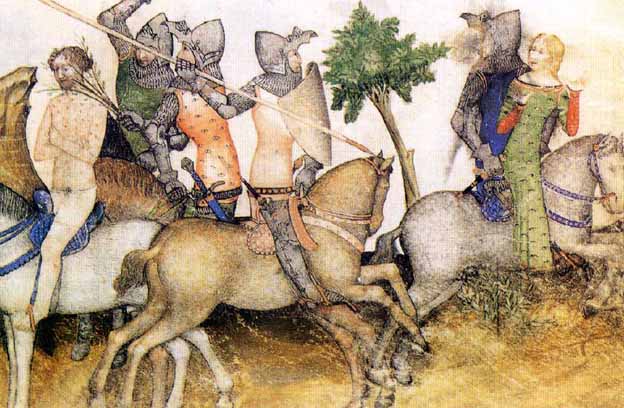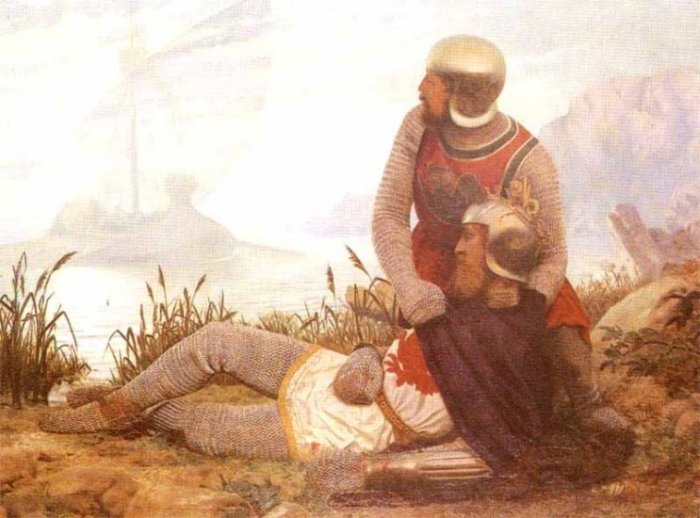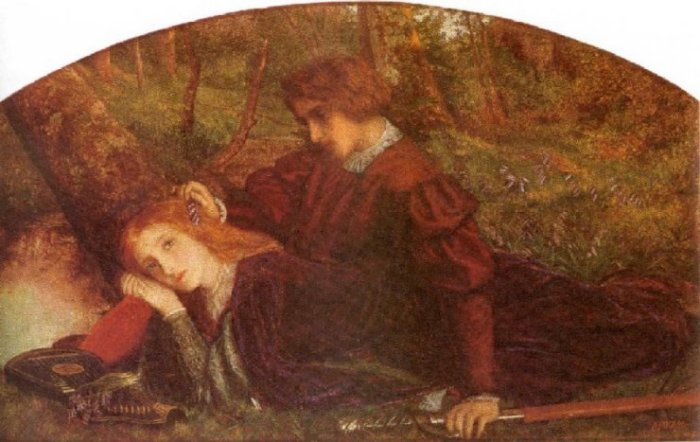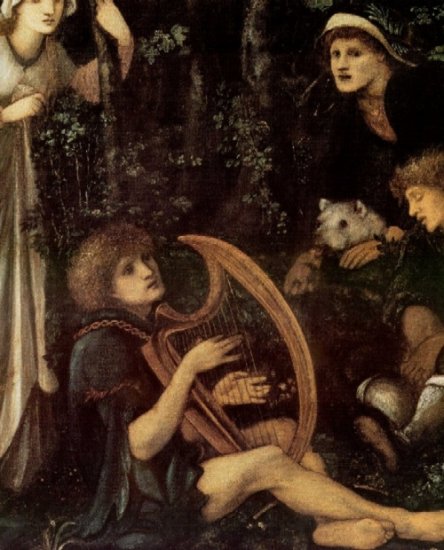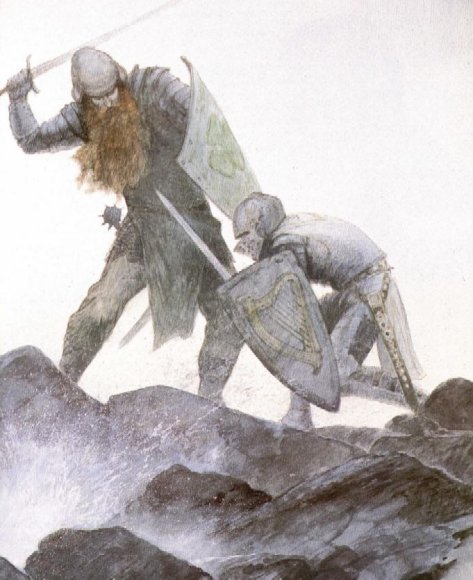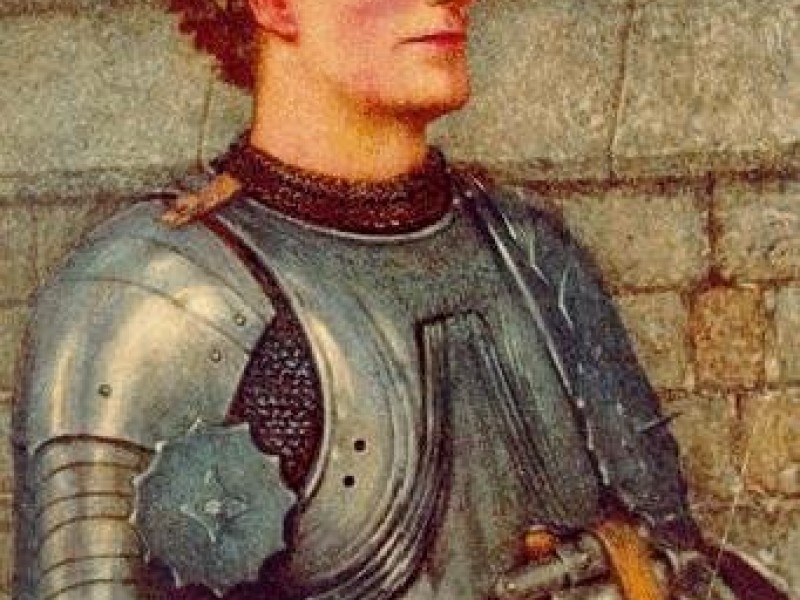Round Table
The Arthurian knights who sat with King Arthur around a circular table became the focal point of fellowship between knights. Some of them are famous as heroes and champions of just cause. In theory, they were brothers; however, jealousy, envy and hatred existed with the fellowship. There were enemies within the Round Table as well as those who were not members of the fellowship. In the end, it was adultery committed by one of its members, Lancelot, with Arthur's queen; the enmity of Gawain; and the betrayal of Mordred that finally brought about downfall of Arthur's kingdom.
You can read about the origin and the meanings of the Round Table in the Origin of the Round Table.
List of Knights
Other Knights
Sir Lamerocke (Lamorak)
Kinsmen of King Arthur
Sir Agravain
Sir Agravain was the son of King Lot of Orkney and Morgawse or Anna. Agravain was also the brother of Gawain. Chretien de Troyes knew him as Agravain the Proud Knight. It was Agravain who tried to prove to his uncle, King Arthur, that Queen Guinevere was committing adultery with Lancelot. When Agravain tried to catch the adulterous lovers in bed. According to the Vulgate text, Agravain was killed by Lancelot, when he was escorting the queen to the stake, while Malory say that Lancelot killed him earlier, just outside of Guinevere's bedchamber.
See the Death of King Arthur.
According to the tale of his brother Sir Gareth in Book VII of Thomas Malory's Morte d'Arthur, Agravain married Lady Lyonesse's niece, Dame Laurel.
Sir Gaheris
Sir Gaheris (called Gaheriet in the Vulgate Cycle, or Keheriet) was the son of King Lot of Orkney and Morgawse or Anna. Gaheris was also the brother of Gawain. According to Malory [le Morte d'Arthur, Vol. 2, Book X Chapter 24], he killed his own mother, Morgawse, when he found her bed with Sir Lamorak.
Gaheriet had opposed of Agravain's plan to exposed the Queen and Lancelot of treachery to the king, because he and Gawain were good friend of Lancelot. By the order of Arthur, Gaheriet (Gaheris) and his brother Guerrehet (Gareth) were reluctant escorts of Guinevere to be executed. The queen was to be burnt at the stake. According to the Mort Artu (Vulgate Cycle), Bors killed Gaheriet (Gaheris), while Lancelot had unknowingly killed Gaheriet (Gaheris). In Mort Artu, it was Gaheriet's death that caused Gawain's enmity towards Lancelot, and prolonged the war war between Lancelot and Arthur. While in Malory's Le Morte d'Arthur say that he and Garth were killed by Lancelot.
See the Death of King Arthur.
According to the tale of his brother Sir Gareth in Book VII of Thomas Malory's Morte d'Arthur, Gaheris married Lady Lyonesse's sister, Dame Lynet (Lynette).
Sir Gareth
Sir Gareth (Guerrehet) was the son of King Lot of Orkney and Morgawse or Anna. Gareth was also the brother of Gawain.
In the final episode of the First Grail Continuation, as Guerrehet avenged the dead knight in the swan-drawn boat.
Before he was knighted, Sir Kay had called him Beaumains and placed him in the kitchen, because he did not reveal his identity in Arthur's court. A whole book [Book VII] of le Morte d'Arthur, was devoted to Gareth's adventures, where he defeated the Red Knight of the Red Launds, thereby winning the hands of Dame Lyonesse. See Sir Gareth in the Tales of the Knights.
When Guinevere was to be burn at the stake for committing adultery with Lancelot, Gareth and his brother Gaheris were the reluctant escorts of the queen. According to Mort Artu (Vulgate Cycle), Bors killed Guerrehet (Gareth) during the rescue attempt to save the queen, but in Malory's Le Morte d'Arthur, Gareth was killed by Lancelot. Gawain's grief over Gareth's death prolonged the war against Lancelot, which would cause the destruction of the Round Table and Arthur's kingdom.
See the Death of King Arthur.
Mordred
Mordred (Modred) was the son of King Lot of Orkney and Anna (according to Geoffrey of Monmouth), but of Morgawse and Lot or her brother Arthur in the Post-Vulgate Cycle. (See Mordred, under Minor Characters for full detail.)
Galeshin
Galeshin (Galescalain). Galeshin was the son of King Neutres (Nentres) of Garlot and Blasine (Elaine), the half-sister of King Arthur. This make Galeshin nephew of Arthur, and cousin to Gawain and Yvain. Galeshin was commonly known as the Duke of Clarence. Galeshin was the cousin of Dodinel the Wildman.
Galeshin was one of the three knights who tried to rescue Gawain (the other knights being Lancelot and Yvain), when his cousin was abducted by Caradoc of Dolorous Tower. In the end, Galeshin and Yvain was also captured, but was eventually rescued by Lancelot.
Galeshin was frequently mentioned, but in most Arthurian tales, he had minor or no role in the legend.
Sir Yvain the Bastard
Sir Yvain the Bastard (Ywain, Owain, Owein, Uwain. Malory called him Uwain les Avoutres). Yvain was the illegitimated son of Urien, so he was not really related to Arthur. In the Vulgate Merlin, Yvain's mother was the wife of Urien's seneschal. Which was why he was named Yvain the Bastard, and he should not to be confused with his more famous half-brother, Yvain, known as the Knight of the Lion, who married the Lady of the Fountain. In the Grail quest (Vulgate Cycle), Yvain was one of the knights killed by Gawain.
Guinglain
Guinglain (Giglain or Gingalin) was famously known as the Fair Unknown. Guinglain was the son of Sir Gawain and a fay named Floree (Wolfram von Eschenbach called her Blancemal which is Blanchemains in French; while in English romance, her name was Ragnell).
Guinglain was the hero of 12th century romance called Le Bel Inconnu, where the hero did not know his name, until he rescued Blonde Esmerée (Fair Esmerée), a princess, who had been turned into a dragon by two evil sorcerers. Though, in the end, Guinglain married Blonde Esmerée, he was loved by another woman named La Pucelle, who was known as the Fée aux Blanches Mains (Fay of the White Hands). His mother only called him Fair Son. See the Fair Unknown article in the Tales of the Knights for the full story.
Guinglain often appeared in the Grail stories. In the Second Grail Continuation (Wauchier de Denain Continuation or Perceval Continuation), where Guinglain fought the Grail hero to a draw, and later meets his father, during a long episode of Gawain's adventure.
Kinsmen of King Ban
Sir Hector
Sir Hector (Hestor, Ector de Maris or Mares or Hector of the Marsh) was the illegitimate son of King Ban and the daughter of li Sires des Mares (or Maris). Hector was the half-brother of Lancelot, who appeared in the Vulgate Cycle and Malory's Le Morte d'Arthur.
Hector took part of the Grail quest, mostly in the company of Gawain. They had no success in the Quest, and Hector return to Arthur's court after Gawain was badly wounded.
Hector supported his brother, when Lancelot came into conflict with Arthur and Gawain. Hector took part in the rescue of Guinevere and two battles against Arthur. Hector took part in the war against Mordred's sons after Arthur's death.
At the end of the Vulgate Cycle, he found Lancelot had taken the monk's habit and Hector died before his brother.
Sir Lionel
Sir Lionel was the son of King Bors of Gaunes and Evainne. Lionel was also the brother of Bors de Ganis (Grail hero). He was the cousin of Lancelot in the Vulgate Cycle, but nephew of Lancelot according to Malory. He was named Lionel at birth, because his mother Evainne saw a strange birth mark his chest, in the shape of lion and the baby strangled it. Lionel became Lancelot's squire during Arthur's war against Galehaut. Lionel was knighted after Arthur's war against the Saxons at La Roche (the "Rock").
Lionel, like the other knights of the Round Table, he took part in the Grail quest. Lionel was captured by two knights where he was badly beaten. His brother Bors had to choose either to save him or a damsel who was about to rape. Because his honour as a knight demand that save a woman before a fellow-knight, even if that the knight in trouble was his own brother. Bors rescued the damsel. Bors discovered later that his brother had managed to escape from his tormentors. Lionel selfishly accused his brother of saving the damsel but not him. Lionel challenged Bors into a duel, who refused to his own brother. A hermit, who tried to intervene and save Bors, was killed. Calogrenant, a fellow-knight had also tried to intervene on behalf of Bors, but he was no match for Lionel, and he too died in combat. Only God saved Bors from Lionel's vengeance by hurling a lightning between the two brothers. Only then did Lionel realised his error. Lionel buried Calogrenant and the hermit, while Bors continued on his quest, meeting Perceval and Galahad.
Lionel sided with his cousin Lancelot, when there was conflict between his kinsman and Arthur. Lionel took part in the rescue of Guinevere, the war at Joyeuse Guard and the war in Gaune, France.
After the battle of Camlann (or Salisbury Plain), Melehan, the son of Mordred, had killed Lionel in the Battle of Winchester according to Mort Artu (Vulgate Cycle).
Other Sons of Pellinor
Sir Lamerocke
Sir Lamorak de Gales (Lamerocke) was the son of Pellehen (Pellinor) and brother of Agloval and Perceval (according to Malory). Lamorak was one of six knights listed as better than Gawain. Gawain and his brethren blamed Lamorak's father for the death of their father (Lot). Gawain and his brothers continued their feud with Lamorak. Gawain and his brothers killed Lamorak. (In Chretien's story of the grail, none of Perceval's brothers or other relatives was given any name, including his father and mother.)
Agloval
Agloval was the son of Pellehen (Pellinor) and brother of Lamorak and Perceval. Agloval and Perceval were two of the knights who found Lancelot and Elaine living on Pelles' island castle. During the Quest, Agloval was another victim of Gawain.
Other Knights
King Baudemagus
King Baudemagus (Bademagu, Bagdemagus) was the king of Gorre, and father of Meleagant (Meliagaunt), who had kidnapped Queen Guinevere, but was killed by Lancelot in single combat (this episode is told by Chretien de Troyes' Knight of the Cart, and Vulgate Cycle called Lancelot). Baudemagus opposed his son about the abduction of Guinevere.
Baudemagus was a nephew of King Urien of Gorre. Baudemagus became king of Gorre, after he surrendered Gorre to King Uther, when Uther had captured Urien. Uther rewarded Baudemagus for his loyalty by crowning Baudemagus as king of Gorre. Urien retire to a hermitage.
In the early part of the Prose Lancelot (Vulgate Cycle), Baudemagus was one of the allies of Galehaut, when Galehaut was at war against Arthur. Baudemagus became Galehaut's deputy. Later, some time after Meleagant's death (after the Vulgate version of the Charrette), Baudemagus became a member of the Round Table, when a knight named Sir Ganor of Scotland died from his wounds he had received from Lancelot at the tournament at Camelot. See Lancelot's adventure in the Tericam.
Gawain killed Baudemagus during the Grail quest (Vulgate Cycle). According to Malory, however, Baudemagus did not died at the quest, and was one of knights, who opposed Arthur when Arthur warred against Lancelot.
Sir Sagremor
Sir Sagremor played a number of minor roles throughout the later Arthurian tradition. Sagremor was the son of Duke Nabur the Unruly. According to the Suite du Merlin, Sagremor became the foster-brother of Mordred, when a fisherman found Mordred in a cradle on the seashore. The fisherman gave the infant to Nabur. (See Morgawse and the Questing Beast.)
He was known as "Sagremor the Unruly", by Chretien de Troyes; in the Vulgate Cycle, he was known as "Sagremor the Foolish"; he was killed by Mordred in the battle of Salisbury Plain (Camlann). While Malory called him "Sagremor le Desirous".
By Jimmy Joe
